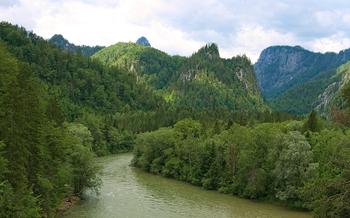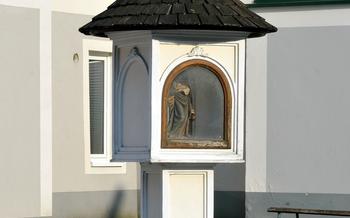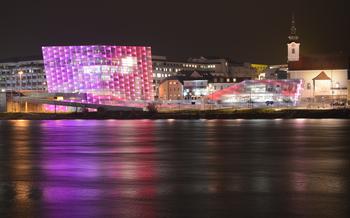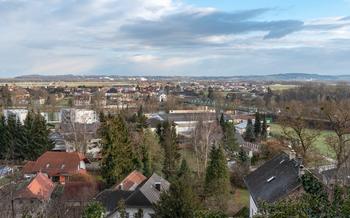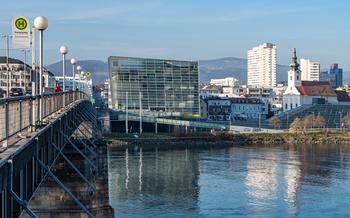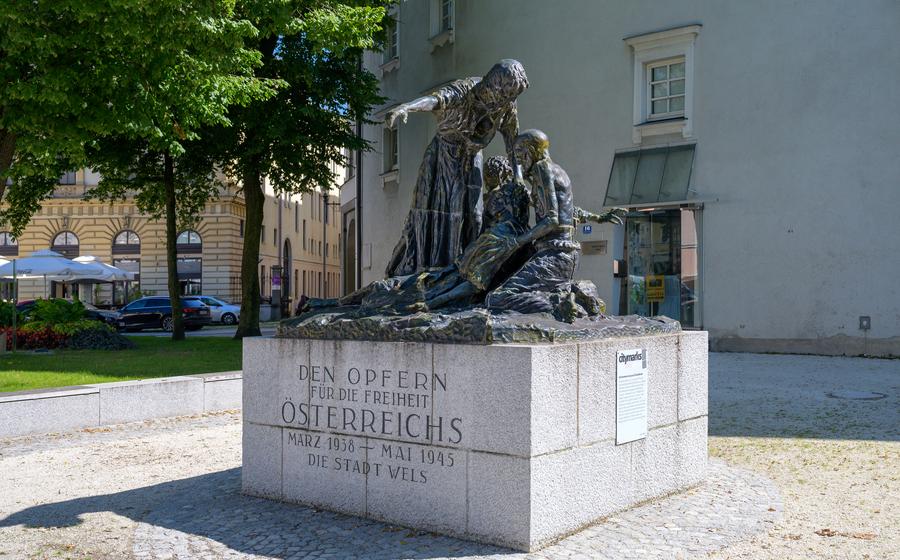
Mauthausen Memorial
- Location and Accessibility
- Hours of Operation and Admission Fees
- Guided Tours and Audio Guides
- Exhibitions and Displays
- Memorial Grounds and Monuments
- The Barracks and Prisoner Cells
- Liberation and Aftermath
- Practical Tips for Visitors
- Transportation Options from Linz
- Nearby Attractions and Landmarks
- Insider Tip: Guided Tour Reservations
Location and Accessibility
The Mauthausen Memorial is situated on a hill overlooking the town of Mauthausen, approximately 20 kilometers east of Linz, Austria. The exact address is Mauthausen Memorial, Erinnerungsstraße 1, 4310 Mauthausen, Austria. To reach the memorial, visitors can take public transportation from Linz, with direct buses departing from the Linz Hauptbahnhof (main train station). The journey takes around 45 minutes, and buses run regularly throughout the day. For those arriving by car, there is ample parking space available at the memorial site. The memorial is wheelchair accessible, with ramps and elevators providing access to all areas of the site, including the museum and the memorial grounds.
Hours of Operation and Admission Fees
The Mauthausen Memorial is open to visitors daily, except for certain holidays. The hours of operation generally run from 9:00 AM to 5:00 PM, but it is always advisable to check the memorial's official website for any seasonal variations or special event closures. Guided tours are available throughout the day, starting at regular intervals, and visitors are encouraged to book their preferred time slot in advance to avoid disappointment.
Admission fees are charged to help maintain the memorial and support its educational programs. The current admission fee is €6 for adults, with reduced rates available for students, seniors, and groups. Visitors can purchase tickets on-site at the memorial's visitor center or book their tickets online through the memorial's website. Advance booking is recommended, especially during peak tourist season, as it allows visitors to secure their spot and skip the queues.
Guided Tours and Audio Guides
Exploring the Mauthausen Memorial with a knowledgeable guide offers a deeper understanding of the camp's history and significance. Guided tours are available in several languages, including English, German, and French. Advance booking is recommended, especially during peak season, to secure a spot and avoid disappointment. The cost of a guided tour is typically included in the admission fee.
For those who prefer a self-guided experience, audio guides are available in multiple languages. These audio devices provide insightful commentary and historical context as visitors navigate the memorial grounds at their own pace. The audio guides are an excellent option for independent exploration, allowing visitors to focus on specific areas of interest and learn at their own pace.
Exhibitions and Displays
The Mauthausen Memorial houses a series of permanent exhibitions and temporary exhibits that provide visitors with a comprehensive understanding of the camp's history and operations. The permanent exhibitions cover various aspects of the camp, including the daily life of prisoners, the forced labor system, the methods of extermination, and the liberation of the camp. Artifacts, documents, and multimedia presentations bring history to life, offering a glimpse into the horrors that took place within the walls of Mauthausen.
Thematic sections within the exhibitions explore the camp's role in the Nazi regime, the experiences of different prisoner groups, and the aftermath of the Holocaust. Interactive elements and educational resources allow visitors to delve deeper into the past, gain insights into the lives of individual prisoners, and reflect on the broader historical context. These exhibitions serve as a powerful reminder of the atrocities committed during the Nazi era and the importance of remembering and learning from history.
Memorial Grounds and Monuments
The Mauthausen Memorial grounds encompass a vast area that includes the former quarry, crematorium, barracks, and a variety of memorials and monuments dedicated to the victims of the camp. The layout of the grounds is designed to provide visitors with a comprehensive understanding of the camp's history and operations.
The most prominent feature of the memorial grounds is the quarry, a large excavated area where prisoners were forced to work under inhumane conditions. The quarry is a powerful reminder of the suffering and exploitation that took place at Mauthausen. Visitors can walk along the "Stairs of Death," a steep and treacherous path that prisoners were forced to climb while carrying heavy loads.
The crematorium and gas chamber are located near the quarry. These structures were used to exterminate thousands of prisoners, and they stand as a stark reminder of the horrors of the Nazi regime. Visitors are invited to reflect on the countless lives lost and the unimaginable suffering that took place within these walls.
Throughout the memorial grounds, visitors will find various monuments and memorials dedicated to the victims of Mauthausen. These memorials include sculptures, inscriptions, and commemorative elements that honor the memory of those who perished. One of the most poignant memorials is a large statue depicting a group of prisoners huddled together in despair.
Guided tours of the memorial grounds provide visitors with a deeper understanding of the camp's history and the significance of the various monuments and memorials. These tours highlight the key features of the grounds, such as the quarry, crematorium, and barracks, and offer insights into the daily lives of the prisoners.
The Barracks and Prisoner Cells
The barracks and prisoner cells at the Mauthausen Memorial provide a stark glimpse into the horrific conditions endured by those who were incarcerated within the camp. The original cell blocks and barracks structures have been meticulously preserved to serve as a testament to the suffering and resilience of the prisoners.
Within the barracks, visitors can see the cramped and unsanitary living quarters where prisoners were forced to sleep in overcrowded bunks. The cells, often shared by multiple prisoners, were dark, cold, and infested with vermin. The lack of basic amenities, such as running water and toilets, added to the prisoners' misery.
Historical accounts and personal testimonies paint a vivid picture of daily life within the barracks. Hunger, disease, and exhaustion were rampant, and prisoners were subjected to constant abuse and degradation by the camp guards. Despite these unimaginable hardships, many prisoners found ways to resist and maintain their humanity. They shared food and stories, supported each other through the darkest of times, and organized acts of defiance, however small.
Walking through the barracks and cells, visitors are confronted with the reality of the Nazi regime's systematic brutality. These spaces serve as a powerful reminder of the resilience and indomitable spirit of those who endured this dark chapter in history.
Liberation and Aftermath
The liberation of Mauthausen on May 5, 1945, by the U.S. Army's 11th Armored Division marked a turning point in the history of the camp. As Allied forces approached, the SS guards attempted to evacuate the camp and force the remaining prisoners on a death march. Thousands perished during this forced evacuation, but many were liberated by Allied troops.
In the aftermath of the liberation, immediate efforts were made to care for the survivors and investigate the atrocities committed at Mauthausen. The camp was declared a crime scene, and a team of investigators began documenting the evidence of mass murder. The findings of this investigation were used in the subsequent war crimes trials of Nazi officials.
In 1947, the Mauthausen Memorial was established on the site of the former camp. The memorial's mission is to document and educate the public about the history of Mauthausen and the crimes committed there. The memorial also serves as a place of remembrance for the victims of the camp.
Every year, on May 5, the memorial holds a remembrance ceremony to honor the victims and survivors of Mauthausen. This ceremony is attended by survivors, their families, government officials, and members of the public. The ceremony includes speeches, prayers, and the laying of wreaths at the memorial's monuments.
The Mauthausen Memorial is a powerful reminder of the horrors of the Holocaust and the importance of remembrance. It is a place where visitors can learn about the history of the camp, pay their respects to the victims, and reflect on the lessons of the past.
Practical Tips for Visitors
When visiting the Mauthausen Memorial, it is important to dress and behave respectfully, mindful of the solemn and sensitive nature of the site. Food and drinks are not permitted within the memorial grounds, but there are designated areas for refreshments and restrooms.
To fully appreciate the memorial's significance, allocate sufficient time for your visit, including guided tours and self-exploration. A comprehensive tour can take several hours, allowing you to delve into the history, exhibits, and memorial grounds at your own pace.
If you plan to stay in the area, consider the various accommodation options near the memorial. There are hotels, guesthouses, and even camping facilities to suit different budgets and preferences. For dining options, there are restaurants and cafes in the nearby towns that offer a range of cuisines and local specialties.
To enhance your visit, consider combining it with other attractions in the region. Linz, the capital of Upper Austria, is a vibrant city with a rich history and cultural scene. It offers museums, theaters, and architectural landmarks, including the Ars Electronica Center, a renowned hub for digital arts and technology.
Transportation Options from Linz
To reach the Mauthausen Memorial from Linz, there are convenient public transportation options available. You can take a direct bus from Linz's central bus station, which departs every hour and takes approximately 45 minutes. The bus stop is conveniently located near the memorial's entrance. Alternatively, you can take a train from Linz's main train station to Mauthausen station, which takes around 30 minutes. From the train station, you can either walk or take a short bus ride to the memorial. The train schedules are coordinated with the bus departures, ensuring a smooth connection.
When planning your trip, check the bus and train schedules to align with your preferred visiting time. The fares for both options are reasonable, and you can purchase tickets directly at the stations or online. Consider combining your visit to the memorial with other attractions in the region, such as the nearby Gusen Memorial or the historic city of Steyr. This will allow you to delve deeper into the history and culture of Austria while making the most of your time in the area.
Nearby Attractions and Landmarks
In addition to the Mauthausen Memorial, visitors can explore a variety of other historical sites and landmarks related to World War II in the vicinity. The nearby town of Gusen was home to a subcamp of Mauthausen, where prisoners were forced to work in underground factories. Visitors can tour the remains of the camp, including the tunnels and chambers where prisoners worked and lived. The neighboring town of St. Georgen an der Gusen also has a memorial dedicated to the victims of the Mauthausen concentration camp system.
Moreover, the region offers an array of museums and exhibits that delve deeper into the history of Austria and the Nazi era. The Nordico Museum in Linz houses a collection of artifacts and documents related to the region's history, including the Nazi period. For those interested in learning more about the Austrian resistance movement, the Museum of the Austrian Resistance in Vienna provides insights into the activities of those who opposed the Nazi regime.
To complement the historical exploration, visitors can immerse themselves in the natural beauty and cultural heritage of the surrounding region. The picturesque countryside of Upper Austria offers stunning landscapes, hiking trails, and cycling routes. The charming towns and villages in the area showcase traditional Austrian architecture, local crafts, and culinary delights. Consider visiting the medieval town of Steyr, known for its well-preserved Old Town and its rich history, or explore the scenic landscapes of the Salzkammergut region, with its pristine lakes, mountains, and charming villages.
By combining a visit to the Mauthausen Memorial with other attractions in the region, visitors can create a comprehensive itinerary for a meaningful and educational trip. The proximity of these sites allows for a deeper understanding of the region's history, the impact of World War II, and the resilience of the human spirit.
Insider Tip: Guided Tour Reservations
Pre-booking a guided tour is highly recommended to ensure availability and avoid disappointment, especially during peak tourist season. Several reputable tour operators offer guided tours of the Mauthausen Memorial, and reservations can be made online or through the memorial's official website.
When selecting a tour, consider your preferred language, group size, and areas of particular interest. Guided tours typically cover the history of the camp, its operation, and the atrocities committed within its walls. They provide in-depth insights and personal anecdotes that bring the past to life, enhancing the overall experience of visiting the memorial.
I personally had the opportunity to take a guided tour of the Mauthausen Memorial, and I found it to be an incredibly enriching and moving experience. The knowledgeable guide provided a comprehensive overview of the camp's history and pointed out key features and memorials that I might have missed on my own. The tour allowed me to gain a deeper understanding of the suffering endured by the prisoners and the significance of preserving this site of remembrance.
